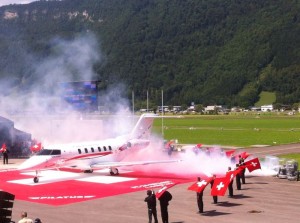
Pilatus PC-24 roll-out
On August first, Swiss National Day, the first prototype of the PC-24 of Pilatus Aircraft Ltd has been rolled out and presented to the public at Stans in Switzerland. The two-engine business jet was developed entirely in Switzerland, with a contribution from the National Aerospace Laboratory (NLR) of the Netherlands in respect of aerodynamics (tests) and simulation. The PC-24 is intended for business travellers, aid organisations and NGOs. Customers have already ordered the 84 jets to be built in the first three years of production.
One of the PC-24’s special features is that it can land and take off on short runways, including unsurfaced ones. This capability makes almost every airport in the world accessible to the PC-24. It is also what makes the PC-24 attractive to business travellers who want to reach their destination as quickly as possible, including areas with scant infrastructure. Its large range of more than 3000 kilometres is one of the reasons why planes of this kind are ideal for aid organisations that often have to operate in large and remote areas. Another exceptional feature of the PC-24 is that its configuration can be changed rapidly. AÂ passenger configuration can quickly be turned into a cargo configuration. Forklift trucks can push relatively large loads sideways into the plane.
NLR contributed to the PC-24’s development in a variety of ways. Among other things NLR produced CFD (Computational Fluid Dynamics) calculations to visualise airflow and other properties by means of computer simulation calculations. The model of the PC-24 was also tested in the DNW wind tunnel at the NLR site in the Netherlands. Aviators extensively tested the model in NLR’s flight simulator called ‘Grace’.
Pilatus will produce three prototypes for the test flight programme. The maiden flight will be in spring 2015. The final certification and first deliveries to customers are scheduled for 2017.
We wish Pilatus all the best with Flight Testing the Plane and bringing it into service.

Roll-out of the PC-24

